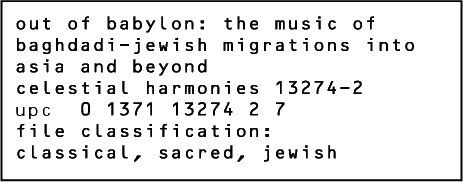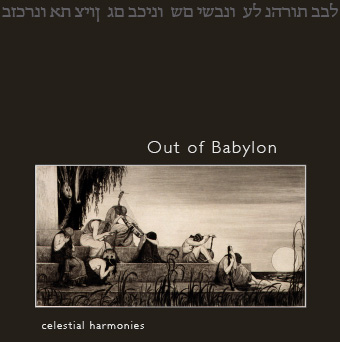(Winner
3rd Quarter 2007 of the Preis der deutschen Schallplattenkritik
[The Annual Award of the German Music Critics])
the project
In 1993 during a visit to carry out some Southeast Asian music
research, Margaret Kartomi stumbled on the Maghain Aboth Synagogue
in Singapore. The congregational community she discovered were
of Baghdadi descent; their forebears had originated in Babylon,
the land of the Tigris and Euphrates rivers and home of the very
first Jewish diaspora 2500 years ago. As is well known, the Jewish
community of ancient Baghdad went on to found a rich civilisation
that would give rise to the great rabbinic academies of learning
in the first three centuries CE, and would eventually come to
influence the traditions of the Sephardi (literally, ‘Spanish’)
and Ashkenazi (east European) Jews.
From the late 18th century, Jewish merchants from the rich and
famous city of Baghdad settled in port cities around colonial-British
and colonial-Dutch Asia, such as in Bombay, Calcutta, Rangoon,
Penang, Singapore, Surabaya, Hong Kong and Shanghai, where they
plied their wares or ran their shipping, spice and clothing businesses.
Kartomi visited and studied the music she recorded of some of
these communities; and fellow ethnomusicologist Sara Manasseh
researched the Baghdadi-Jewish music of her hometown, Bombay.
As they found, families such as the Sassoons and the Kadooris
had made significant contributions to life in their local cities,
such as setting up the tramcar system in early 20th century Hong
Kong; but they also lovingly maintained the Baghdadi way of life
(minagh babli, ‘Babylonian custom’) across the generations,
built Baghdadi-style synagogues and practised their music-liturgical
tradition in their numerous synagogue services. To this day the
community claims that they have succeeded in preserving their
ancient tradition, singing many of the same liturgical melodies
as in past generations. Research has shown that some of the songs
sung today resemble those recorded by the musicologist Idelsohn
in the Baghdadi community in Israel early in the 20th century,
although the styles of singing vary according to the background
and experience of each singer.
As the colonial era came to an end around 1950, members of the
Asian-Baghadi diaspora communities and those in Baghdad itself
emigrated again, settling in cities in Israel, the UK, Canada,
USA and Australia. When Manasseh and Kartomi recorded the liturgical
music in the synagogues in cities such as Manchester and Sydney,
they found remarkable similarities to the performances they had
recorded in Bombay, Singapore, Hong Kong, etc. and that they also
resembled those recorded by Idelsohn a century before. Clearly
the cantors’, rabbis’ and worshippers’ belief that
they had preserved ancient music-liturgical practice had some
truth in it. Though some relatively minor changes can be observed
in the recordings made in different eras, individual singers continue
to sing the same texts set to basically the same melodic ideas,
though they are free to vary them on the spur of the moment, creatively
ornament a melodic phrase, add melismatic notes, and vary the
rhythms in their own personal style, as did their forebears over
the centuries.
Thus, in principle the music on this CD belongs to the ancient
tradition of Bagdhadi-Jewish music. In fact it documents songs
performed (i) in the synagogues of the Baghdadi-Jewish diaspora
in Asia from the end of the 18th to the mid-20th centuries, and
(ii) in a further diaspora since the 1950s to Australia, the UK,
and beyond. The songs were recorded in Bombay, Poona, Singapore,
Shanghai, Hong Kong, Manchester, London and Sydney by ethnomusicologists
Margaret Kartomi and Sara Manasseh of Melbourne and London respectively
as part of the CD project team which also included Regina Randhofer
of Halle, Germany and Bronia Kornhauser of Melbourne. Randhofer’s
interest in psalmody led her to the National Sound Archives in
Jerusalem. From there she selected a number of valuable historical
recordings, originally collected in Iraq and Israel, to provide
more comparative material for the CD. Kornhauser has been the
research archivist for the Australian Archive of Jewish Music
(in the School of Music, Monash University) since its inception
in 1995 and has been collaborating with Kartomi for a number of
years in researching the Jewish music of the Asia-Pacific region.
The CD is one of the outcomes of that research. Although the recordings
that it contains have a documentary character, they have been
carefully prepared to maximise their audio-technical qualities.
tracklist
| 1 |
Anenu - Rahum wehannun |
4'27" |
| 2 |
Rahum wehannun |
2'31" |
| 3 |
Abinu malkenu |
1'50" |
| 4 |
Abinu malkenu |
1'07" |
| 5 |
Schema/adonay hu haelohim/adonay melekh |
1'45" |
| 6 |
Schema/adonay hu haelohim/adonay melekh |
1'52" |
| 7 |
Shomer yisrael/Qaddish/Shofar blowing |
2'52" |
| 8 |
El rahum shemakh |
0'50" |
| 9 |
Ki eshmerah shabbath |
0'16" |
| 10 |
Ki eshmerah shabbath |
0'26" |
| 11 |
Ki eshmerah shabbath |
1'23" |
| 12 |
Ki eshmerah shabbath |
0'26" |
| 13 |
Ki eshmerah shabbath |
0'27" |
| 14 |
Ki eshmerah shabbath |
0'28" |
| 15 |
Balini-b balwa |
0'57" |
| 16 |
Deror yiqra |
0'57" |
| 17 |
Deror yiqra1 |
1'15" |
| 18 |
Deror yiqra |
1'28" |
| 19 |
Deror yiqra |
1'11" |
| 20 |
Yom hashshabbath |
2'21" |
| 21 |
Yom hashshabbath |
2'22" |
| 22 |
Yom hashshabbath |
3'30" |
| 23 |
Yom zeh leyisrael |
1'35" |
| 24 |
Lekhah dodi |
1'15" |
| 25 |
Sur mishello |
0'41" |
| 26 |
El me-od na alah |
0'50" |
| 27 |
Yahh habibi |
2'56" |
| 28 |
Emunah |
1'21" |
| 29 |
Yosheb |
3'06" |
| 30 |
Torath emeth nathan |
1'19" |
| 31 |
Maqheloth am |
1'25" |
| 32 |
Emeth atah hathanenu |
2'15" |
| 33 |
Yehi shalom beheylenu |
1'26" |
| 34 |
Psalm 1, 1934 |
0'53" |
| 35 |
Psalm 1, 1951 |
0'35" |
| 36 |
Psalm 1, 1973 |
0'43" |
| 37 |
Psalm 1, 1979 |
0'38" |
| 38 |
Psalm 137, 1951 |
2'04" |
| 39 |
Psalm 137, 1967 |
1'39" |
| 40 |
Psalm 137, 2001 |
2'26" |
| 41 |
Middan nishma |
0'48" |
| 42 |
Asher hosethikha |
0'15" |
| |
Total Time: |
65'45" |






